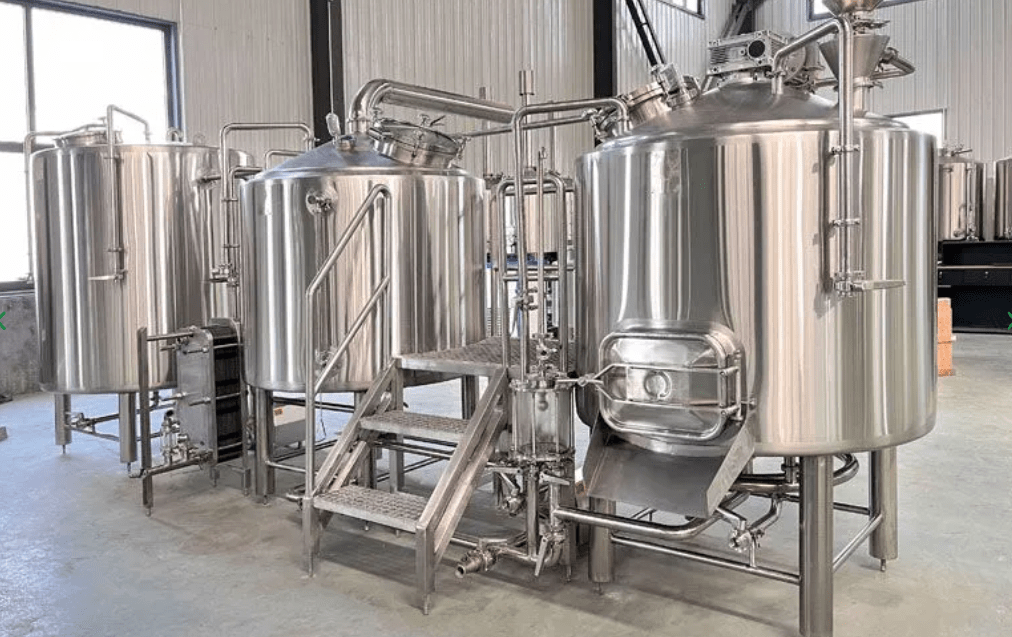At Micet, we offer a diverse range of brewing system sizes to accommodate the needs of breweries of all scales, from small craft breweries to large industrial operations. Our systems range from compact pilot and nano systems, ideal for experimental and small-batch brewing, to large commercial systems designed for high-volume production. Whether you’re just starting out or looking to expand your existing operations, we provide customizable solutions to suit your brewing goals and production capacity.Beer Brewery Equipment Manufacturer

Understanding the Different Sizes of Brewing Systems
1. Pilot and Nano Systems (1-5 BBL):
Pilot and nano systems are typically the smallest brewing systems, ranging from 1 barrel (BBL) to 5 BBL in capacity. These systems are perfect for experimental brewing, recipe development, and small-batch production. They are often used by startups, brewpubs, and larger breweries for pilot testing.
- Benefits:
- Flexibility: Ideal for experimenting with new recipes and brewing techniques.
- Cost-Effective: Lower initial investment and operating costs make them accessible for new brewers.
- Space-Saving: Compact design is suitable for locations with limited space.
2. Microbrewery Systems (5-15 BBL):
Microbrewery systems are designed for breweries that produce beer on a moderate scale, typically ranging from 5 BBL to 15 BBL. These systems are suitable for microbreweries and brewpubs that want to produce a variety of beers and have enough capacity to supply local markets.
- Benefits:
- Versatility: Capable of producing multiple batches per day, allowing for a diverse beer portfolio.
- Scalability: Systems can often be expanded with additional tanks or equipment as the brewery grows.
- Balance: Offers a balance between production volume and operational efficiency.
3. Commercial Brewery Systems (15-50 BBL):
Commercial brewery systems, ranging from 15 BBL to 50 BBL, are designed for larger breweries that distribute their products regionally or nationally. These systems are built for efficiency, consistency, and high-volume production, making them ideal for established breweries looking to scale up their operations.
- Benefits:
- High Efficiency: Designed for continuous operation, maximizing output and minimizing downtime.
- Consistency: Advanced automation and control systems ensure consistent quality across large batches.
- Distribution Ready: Suitable for bottling, canning, and kegging on a large scale, supporting wider distribution networks.
4. Industrial Brewery Systems (50+ BBL):
Industrial brewery systems are the largest systems available, typically exceeding 50 BBL in capacity. These systems are used by large-scale breweries that produce beer in substantial volumes for national and international distribution. They are equipped with the latest technology to ensure optimal efficiency and product quality.
- Benefits:
- Maximum Output: Capable of producing large volumes of beer, meeting the demands of extensive distribution channels.
- Advanced Technology: Incorporates state-of-the-art brewing technology for precision control and monitoring.
- Economies of Scale: Large-scale production reduces per-unit costs, increasing profitability.
Factors to Consider When Choosing a Brewing System Size
Selecting the right size for your brewing system depends on various factors, including your production goals, budget, available space, and market strategy. Here are some key considerations:
- Production Capacity: Assess your current and projected production needs. Smaller systems are ideal for startups and pilot testing, while larger systems are necessary for high-volume production.
- Space and Infrastructure: Consider the physical space available in your facility, including ceiling height, floor space, and utilities like water, gas, and electricity.
- Scalability: Choose a system that can be easily expanded or upgraded as your brewery grows.
- Budget: Factor in not just the initial cost of the system but also operational costs, including energy consumption, maintenance, and labor.
- Market Strategy: Your target market and distribution plans will influence the size and type of system you need. For example, a focus on local markets may require smaller systems, while broader distribution may necessitate larger systems.
FAQs1. What are the benefits of starting with a smaller brewing system?
Starting with a smaller brewing system, such as a pilot or nano system, allows new breweries to experiment with recipes, fine-tune processes, and establish a market presence without significant financial risk. These systems are cost-effective, require less space, and can be scaled up as demand grows.
2. How can I determine the right size of brewing system for my brewery?
To determine the right size of brewing system, consider your production goals, budget, and available space. It’s also important to think about your growth plans and market strategy. Consulting with experienced brewing equipment manufacturers like Micet can provide valuable insights and help you make an informed decision.
3. Can I upgrade or expand my brewing system as my business grows?
Yes, many brewing systems, especially those designed by Micet, are scalable. This means you can add additional tanks, upgrade control systems, or expand your facility to increase production capacity as your brewery grows. It’s important to plan for scalability from the start to facilitate seamless expansion.
4. What is the typical lead time for manufacturing and installing a brewing system?
The lead time for manufacturing and installing a brewing system can vary depending on the size and complexity of the system, as well as the current demand. Generally, smaller systems may take a few months, while larger, more complex systems can take longer. It’s advisable to discuss timelines with your equipment manufacturer early in the planning process to align expectations and schedules.
learn more:https://www.micetgroup.com



